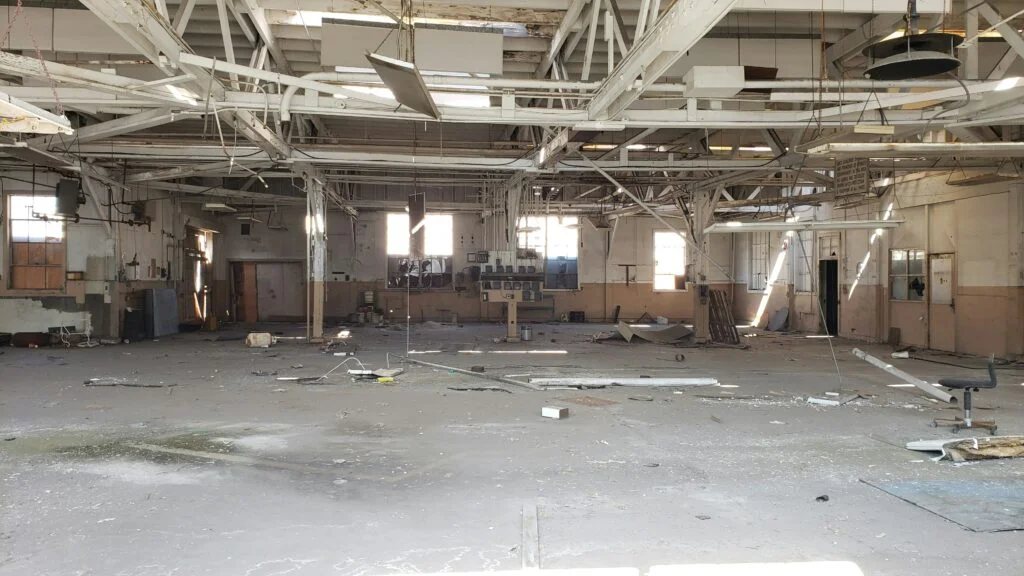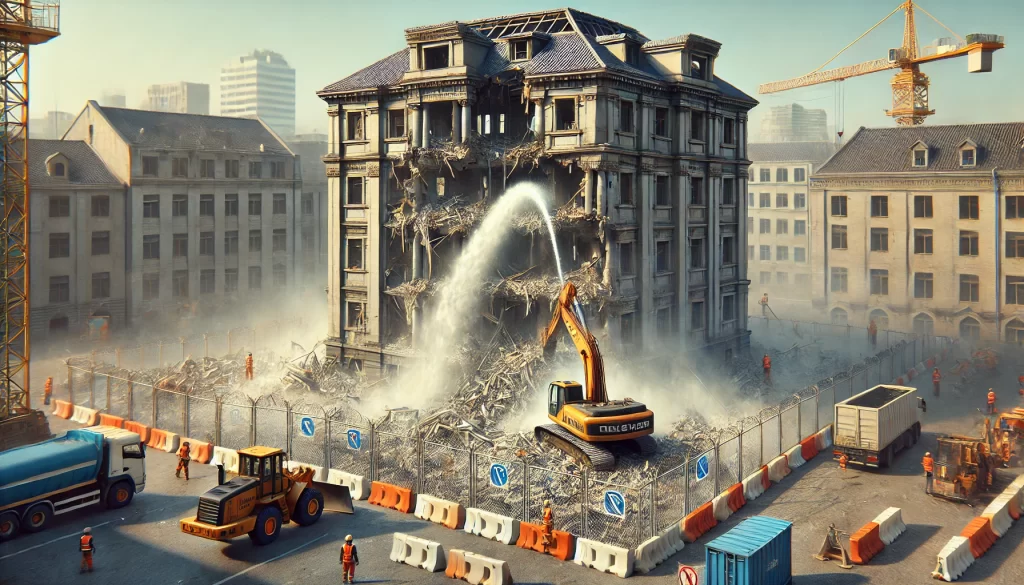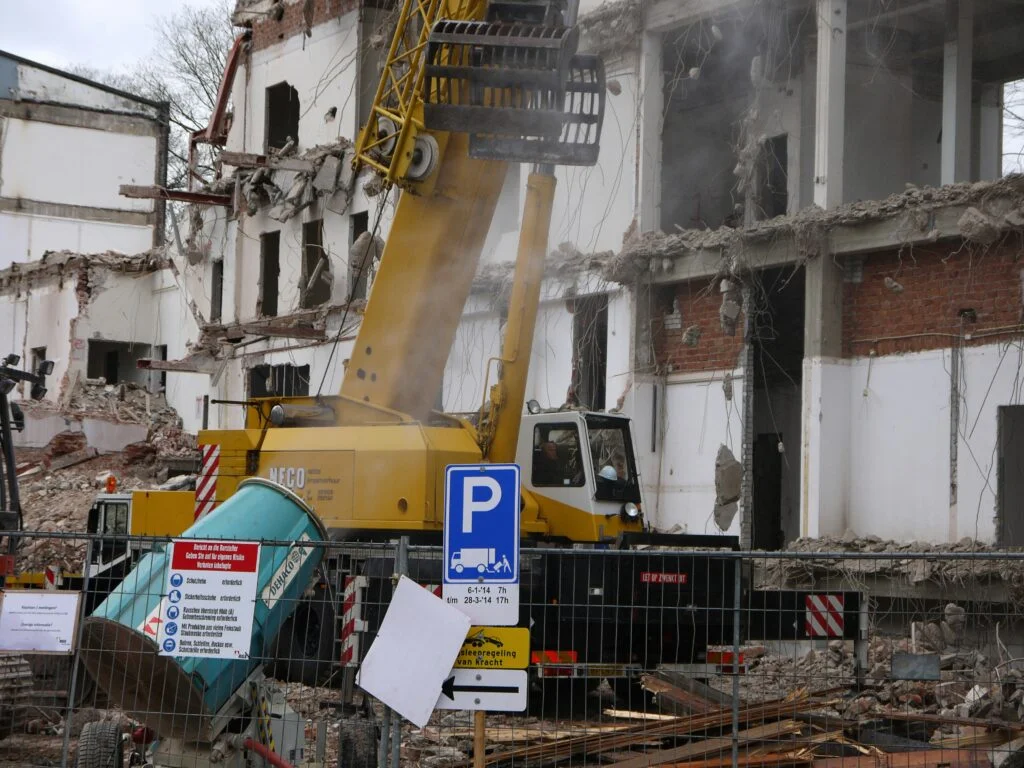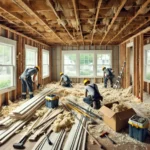Demolition sites are often a cacophony of crashing materials, roaring machinery, and billowing dust clouds. But what if we told you there’s a way to manage this chaos? With the right strategies, it’s possible to keep noise and dust under control, ensuring a safer and more efficient work environment.
In this article, we’ll explore techniques to tame the twin beasts of demolition: Noise and dust. We’ll delve into the science behind these issues, why they matter, and most importantly, how to effectively manage them. So, let’s equip ourselves with the knowledge to transform our demolition sites from a storm of sound and dust into a well-oiled machine!

Understanding the Importance of Managing Noise and Dust During Demolition
In demolition processes, handling noise and dust isn’t merely about maintaining a clean worksite; it’s crucial for preserving health and prioritizing environmental sustainability.
Health Implications
Sound and airborne particles in demolition environments pose threats to worker well-being. Excessive noise leads to hearing loss, interferes with communication, and causes stress disorders. Dust generated, laden with silica or asbestos fibers, triggers respiratory illnesses like asthma and silicosis. By managing these elements, we are helping ensure a safer workplace.
Environmental Impact
Beyond occupational health, managing noise and dust is vital for the surrounding environment. High noise levels disturb local wildlife, affecting reproduction and migration patterns. Dust, when not controlled, disperses into the atmosphere, contributing to air pollution. In taking responsibility to curtail these byproducts, we are doing our part to reduce environmental degradation.
Strategies for Noise Reduction in Demolition Sites
The ability to counter demolition noise involves strategic planning and creative solutions. These strategies primarily revolve around using specific materials and choosing optimal times for executing the demolition.
Using Sound-Dampening Materials
Incorporating sound-dampening materials provides a notable reduction in noise levels at demolition sites. Materials like sound blankets, acoustic curtains, and noise barriers can minimize noise pollution effectively. Sound blankets, for instance, absorb sound waves rather than reflect them, mitigating the overall noise level. Similarly, acoustic curtains, lined with sound-absorbing materials, can block noise from escaping the immediate work area. Noise barriers, such as sound walls or fences, erect an obstruction that prevents the direct transmission of sound to surrounding areas. While these materials reduce noise, they don’t eliminate it entirely.
Scheduling Demolition During Less Sensitive Times
Determining the timelines for demolition tasks is an equally important strategy for noise reduction. Conducting loud demolition jobs in off-peak times reduces the disturbance to surrounding businesses and residents. However, local regulations regarding noise ordinances should be adhered to before setting demolition schedules. Crafting a balanced schedule keeps the noise impact minimal while ensuring the project’s timeline remains on track.
Effective Dust Control Techniques

In the pursuit of managing dust during a demolition project, various techniques prove substantial. Below, we’ll go into specifics about effective dust control methods:
Wet Demolition Methods
Water used during demolition operations serves as the most popular and practical method for dust control. When applied, it suppresses dust by trapping particles before reaching the air. Two common techniques involved are:
- Wetting: This technique involves soaking the material with water prior to demolition. Water soaks into the materials, resulting in less dust generation during the demolition process. For example, one can use water sprays or hoses aimed at the surfaces being demolished to dampen the material.
- Fogging/Misting: Here, fine droplets of water spray in the air to combine with airborne dust particles. The additional weight forces the dust to settle, effectively reducing airborne dust. Equipment such as misting cannons or fog systems best serve this purpose.
Dust Suppression Tools and Equipment
Several tools and equipment aid in dust control at demolition sites. Note these two significant types:
- Air Filtration Devices: Such devices remove dust from the air within buildings and confined spaces. A pre-filter captures the larger particles, while a secondary HEPA filter traps fine particles. Air scrubbers exemplify this type of equipment.
- Personal Protective Equipment (PPE): PPE specially designed for dust control, protects workers from inhaling harmful dust particles. Dust masks and respirators fall under this category. It’s crucial that workers use PPE that is suitable for the type and amount of dust they might be exposed to during demolition.
In the pursuit of dust control, the value of planning, selecting the right strategy, and using appropriate equipment remains undeniable. By combining these methods, we create safer and cleaner demolition sites for everyone involved.
Regulatory Requirements and Compliance

Sound and dust management at demolition sites aren’t just best practices, they’re often legal requirements, too. Adhering to such standards ensures safety, efficiency, and compliance with governing bodies.
Local Noise Ordinances
Local noise ordinances are community-specific regulations designed to curb the negative impacts of excessive noise. Regulated decibel levels, designated quiet hours, and other restrictions can vary from one municipality to another. For instance, urban areas may have more stringent rules compared to rural regions. Compliance with these regulations minimizes disruptions to residents, businesses, and local wildlife. Failure to adhere to these ordinances may lead to penalties, fines, or even the suspension of activities.
Environmental Protection Agency Guidelines
Similarly, the Environmental Protection Agency (EPA) enforces guidelines to mitigate the impact of dust from demolition activities. These measures primarily target the emission of harmful pollutants into the air. For example, the EPA’s National Ambient Air Quality Standards (NAAQS) regulate the amount of particulate matter (PM) that can be released in a given area. Dust control strategies, such as wetting materials before demolition, using filtration systems, and containing the job site, play crucial roles in meeting these guidelines. Failing to comply can lead to similar consequences as non-compliance with noise ordinances, stressing the importance of appropriate dust and noise management practices during demolition operations.
Note: Always check local and federal regulations before beginning a demolition project to ensure full compliance. Learn more about permits for demolition projects in Baltimore.
Conclusion
Managing noise and dust during demolition isn’t just about keeping a clean worksite; it’s about safeguarding the health of our workers and the environment. We’ve discussed the potential health risks from excessive noise and dust, as well as strategies to reduce these hazards. The use of sound-dampening materials and careful scheduling are key in this process. Regulatory compliance isn’t optional—it’s a legal obligation. Adhering to local noise ordinances and EPA guidelines ensures safety, efficiency, and environmental protection. Non-compliance isn’t worth the risk of penalties, fines, or suspensions. So, before the first brick falls, let’s ensure we’ve checked and are in line with all local and federal regulations. Because when we manage noise and dust effectively, we’re not just doing demolition—we’re building a safer, healthier future. To talk to an expert about your next Baltimore demolition project, contact Bella Contracting Services.



